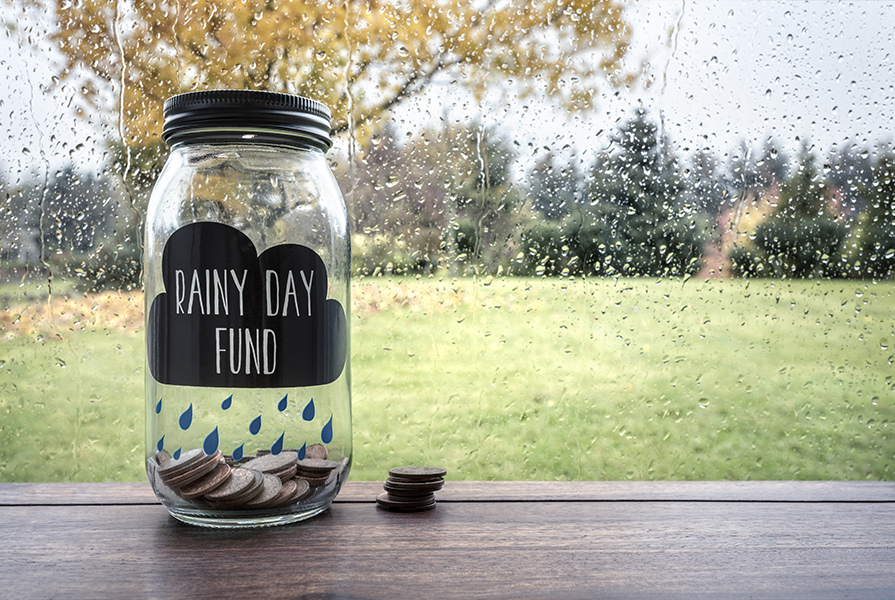Life happens. Cue insurance commercial. But you don’t trust insurance companies, and not everything is insured. So how do you protect yourself from financial emergencies? How do you know you won’t get laid off? How do you know you won’t need some emergency medical procedure next week? You don’t. You need some emergency funds. In this post, I’ll attempt to answer the question: “how much should you save for a rainy day fund?”
How Much Should You Save For A Rainy Day Fund?
Conventional wisdom says you should save up to 6 months of money for your rainy day fund. I hate conventional wisdom and it’s too risky.
My recommendation is you save 6-24 months of savings, depending on your risk tolerance. For my personal risk tolerance, I’d say 18 months of expenses + emergencies is good (more on the mechanics and math later).
But why up to 24 months? When you need to tap into your rainy day / emergency fund, it’s not because you want to. One or more of these things has happened:
- You got fired / laid off, or employed somehow.
- You, or a family member has some health emergency that isn’t “fully” covered by our very shitty, 3rd-world health insurance system.
- You made some bad investments and now you’re in a lot of debt, kinda like that CEO guy in Squid Games.
- Some other severe or unfortunate financial event.
Finding a new job isn’t trivial. It takes time. 6 months is plausible, but it isn’t always the case you’ll find a new job within 6 months, especially if you need to set some income requirements.
And suppose you could find a job within 6 months. There’s no guarantee that is the specific financial emergency to hit you.
In general, when you fall into ‘hard times’, you shouldn’t expect to get out of it within a couple of weeks, or even months. If you could, it wouldn’t be called ‘hard times’ and you wouldn’t need a rainy day fund.
Keeping this in mind: you could save 6 months expenses in your rainy day fund – it’s possible, but it’s better to do 24 months instead + emergency money.
Some Examples Of How Much To Save For Your Rainy Day Fund.
Keep in mind if your health isn’t in great shape (or a family member’s) – you need to add worst-case hospital costs to your emergency funds.
I’m calling out medical bills separately because that’s the highest emergency spending. If you’re in 3rd-world shit-ass America, anyway. Some examples:
- Suppose your nominal costs are $2500/mo. And you hope to save up 24 months of expenses = $60K savings. But you estimate that if something bad were to happen to you, you might need $100K in emergency hospital bills (think: cancer treatment, which very frequently causes people to liquidate their houses because insurance companies just take your money and will always find a loophole to not ‘cover’ you when you need them the most – they’re incentivized to do that). Hence, you should save up $60K + $100K = $160K for your emergency / rainy day fund.
- Now let’s say you have a different profile. Your expenses are $500/mo. You only want to save up for 6 months, or $3000. You hate your parents and don’t want to cover their medical emergencies. And the worst thing that’s ever happened to you is a cold. So you decide to add another $500 in case you need to visit a doctor for 11 minutes (welcome to American healthcare, BABY) – so you need to save $3000 + $500 = $3500 for your rainy day fund.
How To Actually Save Money
First, you might be thinking “Wow! 6 figures! That’s a lot of money to save!” or some other limiting belief that is not grounded in reality.
Or you might be tempted to say:
Everyone else is not saving this much – so why should I? If what this blog says is true, then everyone will be screwed by medical emergencies anyway. Even if I get screwed, I’ll cross that bridge when I get there and just suffer with everyone else.
First, “crossing that bridge when you get there” is procrastination. And you shouldn’t procrastinate with emergencies. Unless you like suffering.
And while misery loves company, suffering with everyone else doesn’t make you suffer any less.
How much you should save isn’t based on emotions. It’s based on math. And empirical data. And empirical data suggests emergency healthcare costs are very expensive in America. Try calling 911 and taking an ambulance to the ER. How much do you think that would cost?
$50? Nope.
$100? Nope.
Try on the order of $1000, if it’s the crappiest ambulance.
Compare this to an ambulance ride I’ve taken in another country, where it only cost $12.50.
If you think health insurance companies will ‘cover you’ instead of rape your money, and that your healthcare costs will be low forever and you’ll never get sick: please get your head out of your fucking ass.
Or don’t. And suffer with everyone else. The only difference between you and other people now is that: you know you’ll be screwed if you don’t save up a ton of money, whereas other people don’t.
So it’s like other people are getting run over by a train they didn’t see coming. You, on the hand, will be looking at train hurling itself at you from the horizon (of probably many years). But you just sit on that railroad for years until it finally comes and kills you. That’s stupid. Don’t do that.
Now that we’ve got your limiting belief that “I can’t save up to 6 figures OMFG!!!” out of the way (hopefully), here’s how you actually do it:
- Get higher paying jobs, every 2 years. This is the best way to get a raise. See the article for my own case study.
- Pay yourself first. A percent of your paycheck should land in a savings / investment account you never, ever touch (AKA your emergency fund). And only after the money has landed there, does the rest of the money touch your checking account, where you can use those funds as discretionary. You should maximize this percentage.
For step 2: you’ll be tempted (especially when money’s tight) to not deposit money in your emergency / rainy day fund. Never do that. You should automate this process so you take all emotion out of saving money for your rainy day fund. Sign up to the 3-day tutorial below for step-by-step screenshots on how you can automate this.
Yes, to save for your rainy day fund is a long-term process. And no, there’s no ‘quick fix’. Folks who look for quick fixes or shortcuts, or want to procrastinate on this will suffer.
And just because this wasn’t something you wanted to hear, doesn’t make it less true. In fact, you probably don’t want to hear that you need to save up $160K for your rainy day fund because you know deep down it’s true. So please get started.












0 Comments